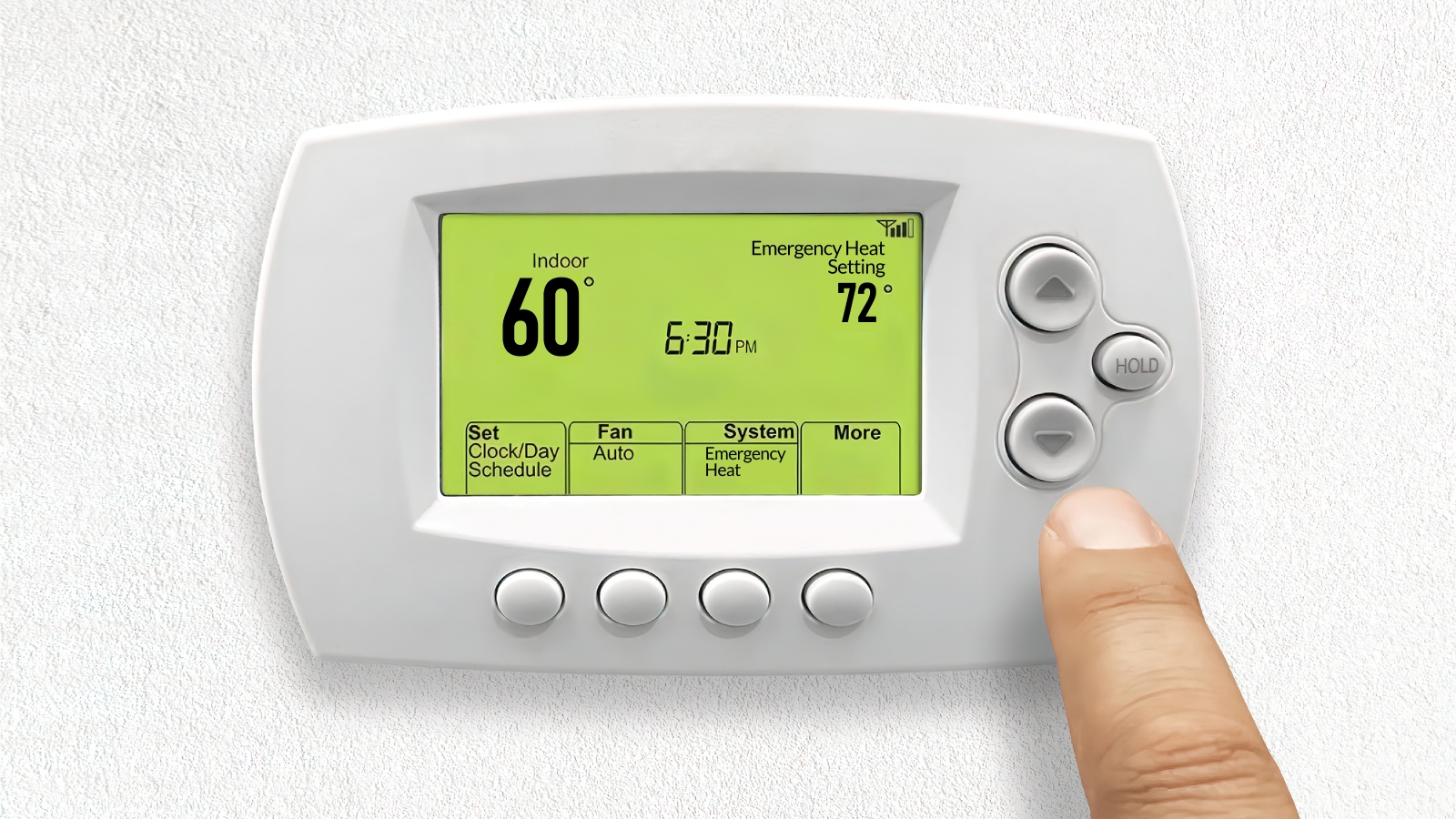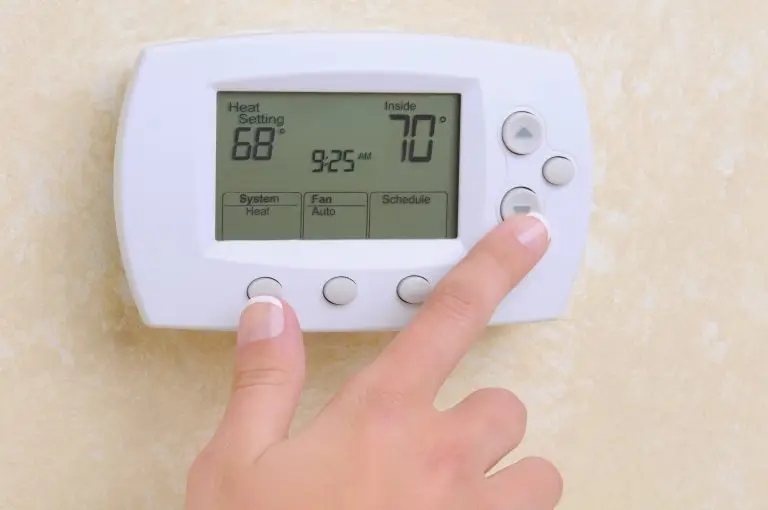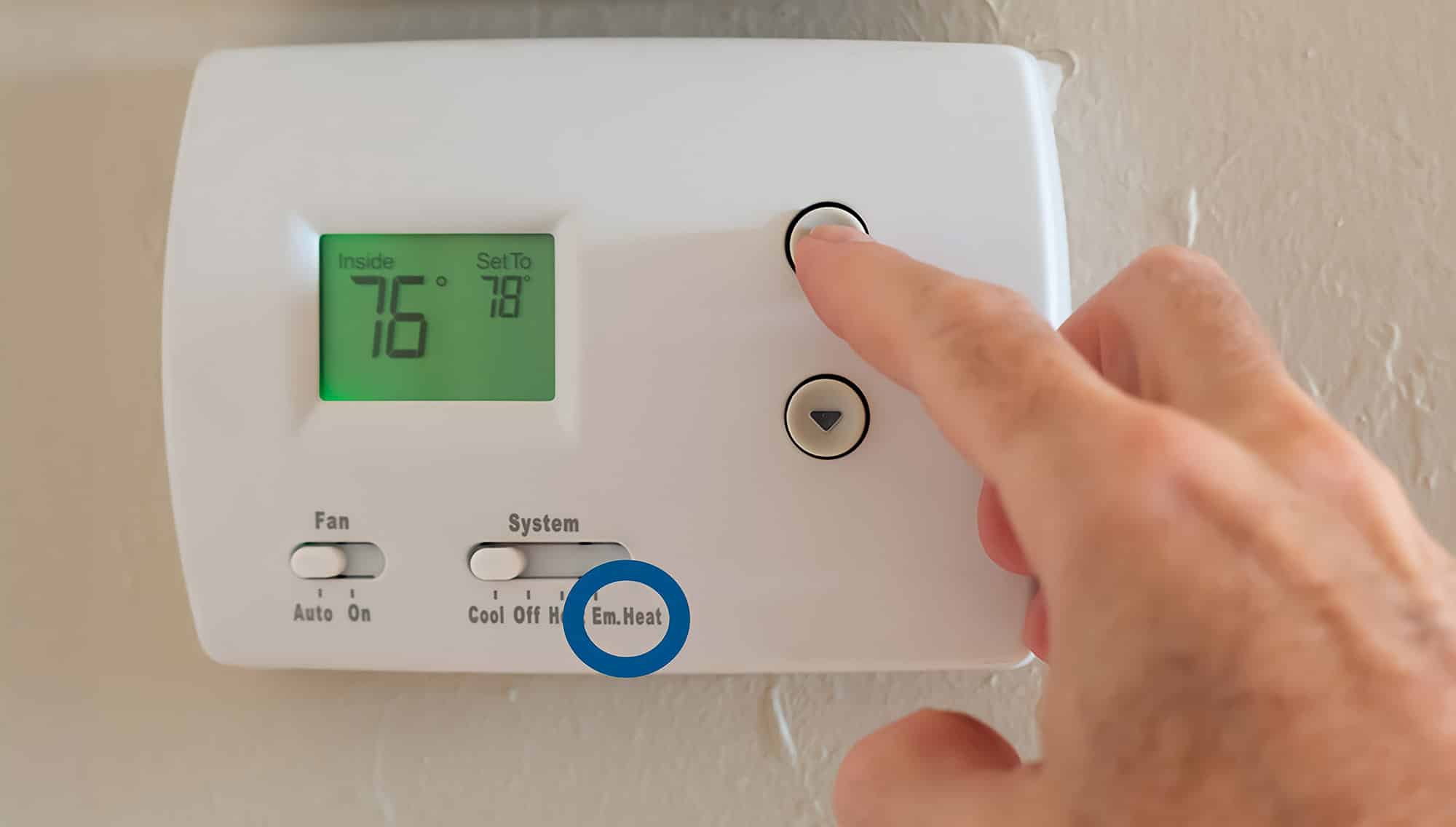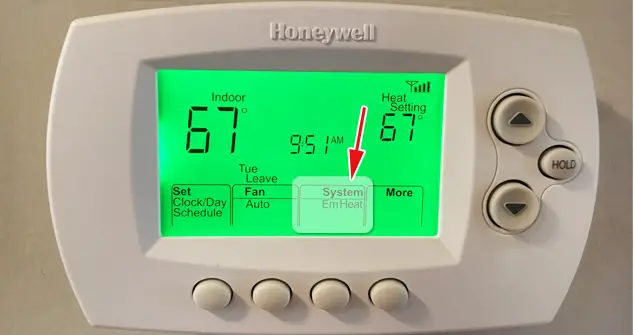Check Best Thermostat Pricing in Amazon
** As an Amazon Associate, I earn from qualifying purchases.
Emergency heat on a thermostat is a backup heating system. It activates during extreme cold or system failure.
Understanding the emergency heat function is crucial for homeowners. This feature kicks in when your primary heating source struggles to maintain warmth. It’s commonly found in heat pump systems, providing an additional layer of comfort during harsh winter conditions. Knowing how and when to use emergency heat can prevent unexpected cold spells and ensure your home stays cozy.
This article will explain the purpose, function, and proper usage of emergency heat on your thermostat. Let’s explore why this feature is essential and how it can be a lifesaver during winter’s chill.

Credit: charlottecomfortsystems.com
Emergency Heat Basics
Understanding emergency heat on your thermostat is crucial, especially during cold winters. This setting offers an additional heating option when regular heat sources fail. Knowing the basics can help you stay warm and avoid costly repairs.
Definition
Emergency heat, also called auxiliary heat, is a backup heating system. It activates when the main heating source, like a heat pump, stops working. This setting ensures your home stays warm until regular heat is restored. It is common in areas with extreme cold.
How It Works
Emergency heat uses electric resistance heating coils or a gas furnace. When you switch to emergency heat, the thermostat bypasses the heat pump. The backup system takes over to provide warmth. This process ensures immediate heat without waiting for repairs.
The emergency heat setting should only be used for short periods. Relying on it for long can lead to higher energy bills. Always monitor your system and switch back to regular heat once the issue is resolved.
When To Use Emergency Heat
When the temperature dips, you might find yourself reaching for that “Emergency Heat” setting on your thermostat. But when exactly should you use it? Understanding the right circumstances can save you both stress and money. Let’s dive into the specifics.
Cold Weather Conditions
Emergency heat is like a backup plan for your heating system. You should use it during extremely cold weather when your heat pump struggles to maintain a comfortable temperature in your home. This usually happens when temperatures drop below 30°F (-1°C).
In such conditions, the heat pump alone may not be effective. Emergency heat uses electric heat strips to warm your home more quickly. This ensures you stay cozy even when it’s freezing outside. Have you ever felt like your home just can’t get warm enough, despite the heating system running constantly? That’s a sign to consider using emergency heat.
System Malfunctions
Another scenario to use emergency heat is when your heat pump is malfunctioning. If your system isn’t working properly, the emergency heat function can act as a temporary fix. This will keep your home warm while you wait for repairs.
For example, if you notice that your heat pump is blowing cool air instead of warm air, it might be time to switch to emergency heat. This can prevent your home from becoming unbearably cold. Have you ever had a heating system breakdown in the middle of the night? Using emergency heat can be a lifesaver in such situations.
Using emergency heat is not for everyday use. It’s a temporary solution for specific conditions like extreme cold or system issues. Keep this in mind to ensure your home remains comfortable and your energy bills stay manageable. Have you ever wondered if you’re using your thermostat settings effectively? Now you know when to switch to emergency heat.
Benefits Of Emergency Heat
Emergency heat on a thermostat is a backup heating system. It activates during extreme cold when the main heat source fails, ensuring warmth and comfort. This feature is crucial for maintaining a safe indoor temperature.
When winter storms hit and temperatures drop drastically, having emergency heat on your thermostat can be a lifesaver. But what are the real benefits of using emergency heat? Let’s dive into some practical advantages.Energy Efficiency
Emergency heat can actually be more energy-efficient in extreme weather conditions. It supplements your primary heating system, reducing the workload on the main unit. This can prevent it from overworking and potentially breaking down. By balancing the load, it ensures your home stays warm without consuming excessive energy.Cost Savings
Using emergency heat strategically can save you money. When your primary heating system doesn’t have to work as hard, it consumes less electricity or gas. This can result in lower utility bills. Additionally, avoiding emergency repairs for an overworked heating system can save you unexpected costs. Imagine avoiding a hefty repair bill in the middle of a cold snap. That’s a huge relief, right? Emergency heat is a smart backup that ensures comfort and efficiency. Have you ever found yourself scrambling for warmth during an unexpected cold front? Next time, think about how emergency heat could be your wallet’s best friend.Potential Drawbacks
Using emergency heat on a thermostat can lead to higher energy bills. It may also cause increased wear on your heating system.
When it comes to understanding the emergency heat function on your thermostat, it’s crucial to be aware of its potential drawbacks. While emergency heat can be a lifesaver when your heat pump fails, it’s not without its downsides. Here, we will delve into some of the most significant disadvantages that you should consider.Higher Energy Costs
One major drawback of using emergency heat is the higher energy costs. Emergency heat relies on electric resistance heating, which is far less efficient than your heat pump. Imagine receiving your electricity bill and noticing a significant spike. This is common when you rely on emergency heat for extended periods. Emergency heat should be a temporary solution. It’s wise to get your heat pump repaired promptly to avoid these extra costs.Wear And Tear
Another concern is the wear and tear on your system. Emergency heat forces your HVAC system to work harder than usual. I once had to use emergency heat for a week during a particularly cold winter. By the end of it, my heating system was making strange noises and required a service visit. Regular use of emergency heat can shorten the lifespan of your heating system. It’s designed for short-term use and extended operation can lead to breakdowns. Have you ever had to rely on emergency heat? How did it affect your energy bills and system performance? Understanding these potential drawbacks can help you use this feature more wisely.Setting Up Emergency Heat
Setting up emergency heat on a thermostat ensures your home stays warm. This feature activates a secondary heat source. It’s important to know how to use it correctly.
Check Best Thermostat Pricing in Amazon
** As an Amazon Associate, I earn from qualifying purchases.
Thermostat Controls
Most modern thermostats have clear controls for emergency heat. Look for a switch or button labeled “Emergency” or “EM Heat.” This is usually found on the main display or behind a cover. Refer to your thermostat’s manual if you’re unsure.
Manual Activation
To manually activate emergency heat, locate the emergency heat switch. Flip the switch to “On” or “EM Heat.” The system should now use the secondary heat source. This can include electric heat strips or a gas furnace.
Remember, emergency heat is for extreme situations. Use it when your primary heat source fails. Check your system regularly to ensure it’s functioning properly.

Credit: craigheadelectric.coop
Maintaining Your Heating System
Emergency heat on your thermostat provides extra warmth during extreme cold. It activates the backup heating system. This ensures your home stays comfortable.
Maintaining your heating system is crucial for ensuring it works efficiently when you need it most. Emergency heat on your thermostat is a backup option for extremely cold weather. To keep your heating system in top shape, regular maintenance is key.Regular Checks
Performing regular checks on your heating system can prevent unexpected breakdowns. Check your thermostat settings monthly to ensure they are accurate. Inspect filters and replace them if they are dirty. Listen for unusual noises coming from your heating system. Strange sounds can indicate a problem that needs immediate attention. Keep the area around your heating unit clear to avoid obstructions. This helps in maintaining proper airflow.Professional Inspections
Schedule professional inspections at least once a year. A licensed technician can identify issues that you might overlook. A professional can also perform tasks that require technical expertise, like checking electrical connections and cleaning internal components. During a professional inspection, ask questions about your system’s performance. Understanding how your heating system works can help you maintain it better. Maintaining your heating system is an ongoing process. Regular checks and professional inspections can save you money and ensure your system runs efficiently. Have you scheduled your next inspection yet?Common Issues And Solutions
Emergency heat on a thermostat activates the backup heating system. Use this feature when the main heat source fails. Always ensure the emergency heat option is turned off when not needed to save energy.
Emergency heat on your thermostat can cause confusion. It’s a useful feature but can bring problems. Understanding common issues helps in finding solutions easily.Troubleshooting Tips
Check if your thermostat is set to emergency heat mode by accident. This can happen during power outages. Ensure it is set to the correct mode. Inspect your thermostat’s battery. Low battery power can cause malfunction. Replace batteries if needed. Verify the wiring connections. Loose or disconnected wires can disrupt function. Secure all connections properly.Repair And Replacement
If troubleshooting doesn’t help, consider repair. Sometimes, a professional can fix minor issues quickly. For major problems, replacement might be necessary. Choose a thermostat that fits your system. Consult a technician for recommendations. Regular maintenance can prevent future issues. Keep your system clean and check it regularly. Remember, addressing issues early can save time and money. Stay proactive with your thermostat’s health. “`
Credit: www.watkinsheating.com
Tips For Winter Heating
Winter can be harsh. Keeping your home warm is essential. Effective heating tips save money and energy. Let’s explore some key techniques for winter heating.
Insulation Techniques
Proper insulation keeps warm air inside. It prevents cold air from entering. Start with your windows and doors. Use weather stripping to seal gaps. Add thick curtains to windows. This blocks drafts. Consider insulating your attic. Warm air rises. Without insulation, it escapes through the roof. Insulate walls too. It reduces heat loss. Use foam or fiberglass insulation. Check for gaps around outlets and pipes. Seal them. This stops cold air from sneaking in.
Alternative Heating Methods
Traditional heating systems can be costly. Try alternative methods. Use space heaters for small areas. They are efficient and cost-effective. Consider a pellet stove. It burns compressed wood or biomass pellets. This is eco-friendly and provides steady heat. Another option is radiant floor heating. It warms up the floor. Heat rises and warms the room. Electric blankets or heated mattress pads can keep you warm at night. They use less energy than heating the whole house. Try these methods. Stay warm and save money this winter.
Frequently Asked Questions
Is It Ok To Run Emergency Heat?
Yes, running emergency heat is safe for short periods. It helps keep your home warm during extreme cold.
When Should You Put Your Thermostat On Emergency Heat?
Use emergency heat only when your heat pump is malfunctioning or during extremely cold weather. This setting bypasses the heat pump, relying solely on electric heat strips.
What Causes Emergency Heat To Come On?
Emergency heat activates due to extremely cold temperatures or a malfunction in the primary heating system. It provides backup heating.
Does Emergency Heat Cost More To Run?
Yes, emergency heat usually costs more to run. It relies on electric heat strips which are less efficient.
Conclusion
Emergency heat on a thermostat is crucial in cold weather. It provides warmth when the main heating system fails. Understanding its purpose helps maintain comfort during winter. Regular maintenance ensures it works efficiently. Always check your thermostat settings for proper use.
Stay prepared to tackle unexpected heating issues. Emergency heat offers peace of mind during harsh conditions. Keep your home safe and cozy by knowing your thermostat’s functions.
Check Best Thermostat Pricing in Amazon
** As an Amazon Associate, I earn from qualifying purchases.


